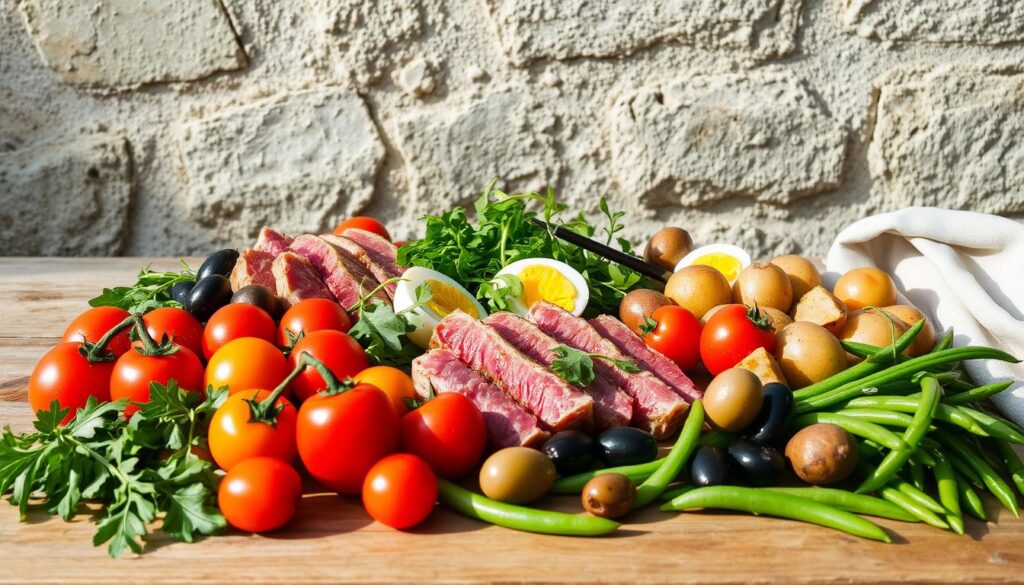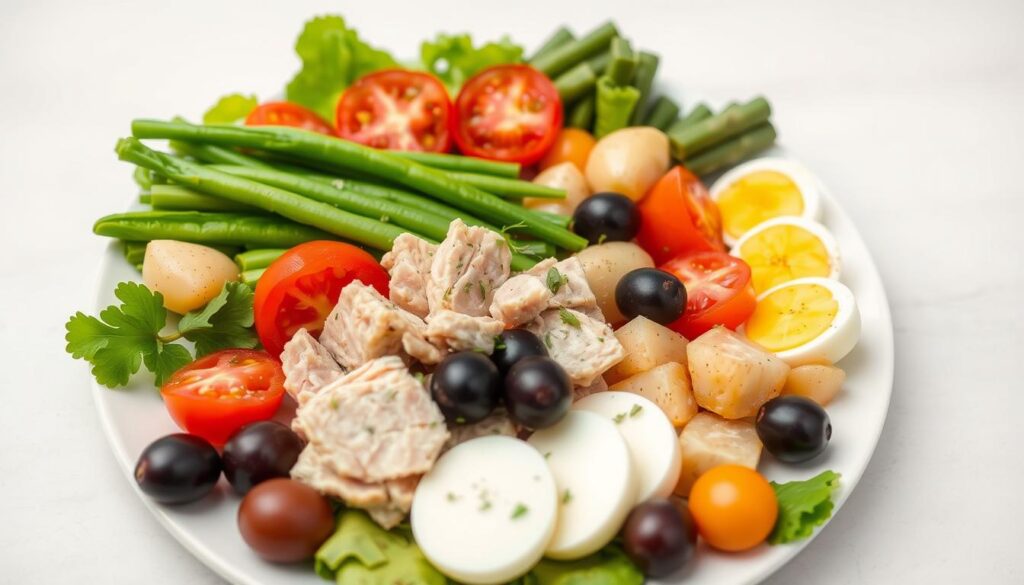Can a simple salad truly capture the essence of a region’s culinary identity? For those familiar with Mediterranean cuisine, the answer lies in the iconic Salade Niçoise, a dish that has traveled the world, captivating palates with its freshness and simplicity.
This quintessential salad from the French Riviera is more than just a mix of ingredients; it’s a representation of the rich culinary heritage of Provence. With its combination of flavors and textures, Salade Niçoise has become a beloved classic, enjoyed by food enthusiasts and newcomers alike.
Key Takeaways
- Discover the origins of Salade Niçoise and its significance in Mediterranean cuisine.
- Learn about the essential ingredients that make this salad a culinary masterpiece.
- Explore the traditional preparation methods that bring Salade Niçoise to life.
- Understand why this salad has gained worldwide popularity.
- Find inspiration to create your own version of Salade Niçoise at home.
The Origins and History of Salade Niçoise
The story of Salade Niçoise begins in Nice, France, where it was first conceived as a simple, yet flavorful salad. This traditional French salad has its roots in the local cuisine of Nice, where it was prepared with ingredients readily available in the Mediterranean region.
From Nice to the World: The Journey of a Classic Dish
Salade Niçoise’s journey from a local specialty to a globally recognized dish is a testament to its enduring appeal. As people traveled and culinary practices evolved, the salad adapted to new tastes and ingredients while maintaining its traditional essence. Today, it is enjoyed not only in France but in restaurants around the world, often served as a symbol of Mediterranean cuisine.
The salad’s popularity can be attributed to its composition of fresh vegetables, protein-rich tuna, and the salty tang of olives and anchovies, all of which are characteristic of the Mediterranean diet. Its adaptability has allowed it to be reimagined in various forms, from traditional recipes to modern interpretations.
Historical Evolution of the Recipe
The historical evolution of Salade Niçoise is marked by the incorporation of new ingredients and cooking techniques. Originally, the salad was a peasant dish made with locally available ingredients such as tomatoes, hard-boiled eggs, and olive oil. Over time, other ingredients like tuna and anchovies became standard components, enhancing the salad’s flavor and nutritional profile.
As culinary practices evolved, so did the preparation methods for Salade Niçoise. The traditional recipe has been refined, with an emphasis on using high-quality, fresh ingredients. This evolution has transformed the salad into a gourmet favorite, enjoyed by food enthusiasts worldwide.
What Makes an Authentic Salade Niçoise?
Authenticity is key when it comes to Salade Niçoise, a dish deeply rooted in the culinary traditions of Nice, France. The authenticity of this salad is not just about throwing together a mix of ingredients; it’s about understanding and respecting the traditional components that make it a true representation of French cuisine.
Traditional Ingredients and Their Significance
The traditional ingredients of Salade Niçoise include fresh vegetables such as tomatoes, bell peppers, and lettuce, which form the foundation of the salad. Other crucial components are hard-boiled eggs, tuna, and olives, all of which contribute to the salad’s rich flavor profile and texture. Each ingredient is significant not just for its taste but also for its cultural and historical context within the region.
The use of high-quality, fresh ingredients is paramount. For instance, the tuna should be of the best quality, often canned in olive oil, and the vegetables should be in season to ensure maximum flavor. The olives, typically Niçoise olives, add a salty, tangy flavor that is characteristic of the dish.
Common Misconceptions About the Classic Recipe
One common misconception about Salade Niçoise is that it can be adapted freely with various ingredients without losing its essence. However, deviating too far from the traditional recipe can result in a dish that is not authentically Salade Niçoise. Another misconception is that the salad is merely a mixture of its parts; in reality, the harmony and balance among the ingredients are what make it authentic.
Understanding these nuances is crucial for anyone looking to prepare an authentic Salade Niçoise. By sticking to the traditional ingredients and respecting their significance, one can create a dish that is not only delicious but also a true representation of French culinary tradition.
Essential Ingredients for the Perfect Salade Niçoise
To make an authentic Salade Niçoise, one must start with the freshest ingredients. The quality of the components directly impacts the overall flavor and texture of the salad.
Fresh Vegetables: The Foundation
The foundation of a great Salade Niçoise is its fresh vegetables, including crisp lettuce, ripe tomatoes, and crunchy peppers. These ingredients not only add texture but also bring a burst of freshness to the salad. It’s essential to choose vegetables that are in season to ensure the best flavor.
Protein Components: Tuna and Eggs
The protein components, typically tuna salad made from canned tuna and hard-boiled eggs, add depth and richness to the salad. The tuna should be of high quality, preferably packed in olive oil, while the eggs should be cooked to perfection to maintain a creamy yolk.
Olives, Anchovies, and Other Mediterranean Staples
Olives, anchovies, and capers bring in the salty, umami flavors characteristic of Mediterranean cuisine. These ingredients are crucial in creating the distinctive taste of Salade Niçoise. The olives should be pitted and preferably of a variety like Niçoise or Kalamata, while the anchovies add a salty, fishy flavor that complements the tuna.
By combining these essential ingredients, you’ll be able to create a Salade Niçoise that is both authentic and delicious. The key is to balance the flavors and textures, ensuring that each component enhances the overall dish.
The Art of Creating Salade Niçoise at Home
Mastering the art of Salade Niçoise at home requires attention to detail and a few simple techniques. This classic Mediterranean salad, originating from Nice, France, is a symphony of flavors and textures that can be recreated in your own kitchen with fresh ingredients and a bit of practice.
Preparing the Vegetables
The foundation of a great Salade Niçoise lies in its fresh vegetables. Start by selecting crisp lettuce, plump tomatoes, and crunchy green beans. Wash and dry the lettuce leaves, slice the tomatoes into wedges, and blanch the green beans to preserve their vibrant color and texture.

Cooking the Eggs to Perfection
Cooking the eggs is a crucial step. For a traditional Salade Niçoise, you’ll want to hard-boil the eggs. Place them in boiling water for 10 minutes, then transfer them to an ice bath to stop the cooking process. Once cooled, peel and slice them into wedges.
Assembling the Salad
Assembling the salad is where you bring all the components together. Start with a bed of lettuce on a large platter or individual plates. Arrange the tomatoes, green beans, and hard-boiled eggs on top. Add canned tuna drained and flaked, and a sprinkle of Niçoise olives and anchovies if you like.
Creating the Classic Dressing
The dressing is the final flourish. A classic vinaigrette made with olive oil, red wine vinegar, and a touch of Dijon mustard brings all the flavors together. Whisk the ingredients together and season with salt and pepper to taste. Drizzle the dressing over the salad just before serving to keep the vegetables crisp.
With these steps, you can create a Salade Niçoise that rivals those found in the bistros of Nice. It’s a dish that’s both simple and elegant, perfect for a light lunch or as a starter for a dinner party.
Popular Variations of Salade Niçoise Around the World
Salade Niçoise has become a canvas for culinary creativity worldwide. As this traditional French salad gains international recognition, it has undergone numerous transformations, adapting to local tastes and dietary preferences.
American Adaptations
In the United States, Salade Niçoise has been adapted to suit American tastes, often featuring larger portions and additional ingredients. Some popular variations include adding grilled chicken or substituting the traditional tuna with other proteins like salmon or tofu.
American adaptations also tend to emphasize freshness and the use of locally sourced ingredients, aligning with contemporary dining trends that prioritize sustainability and farm-to-table cuisine.
Modern Chef Interpretations
Renowned chefs around the world have put their own spin on Salade Niçoise, incorporating innovative flavors and presentation styles. These modern interpretations often maintain the core elements of the dish while elevating its sophistication.
For instance, some chefs may use sous vide cooking for the eggs, add exotic spices, or present the salad in a deconstructed format. These creative twists not only pay homage to the original recipe but also push the boundaries of culinary art.
Vegetarian and Vegan Alternatives
To cater to the growing demand for plant-based cuisine, vegetarian and vegan versions of Salade Niçoise have emerged. These alternatives replace the traditional tuna with ingredients like marinated and grilled portobello mushrooms or tofu, maintaining the protein component of the salad.
Additionally, vegan adaptations often involve substituting anchovies with other umami-rich ingredients, such as seaweed or mushroom-based products, ensuring that the flavor profile remains rich and satisfying.
These variations demonstrate the versatility of Salade Niçoise, allowing it to be enjoyed by a diverse range of consumers while maintaining its essence as a quintessential Mediterranean salad.
The Nutritional Profile of Salade Niçoise
Salade Niçoise stands out as a healthy choice, thanks to its composition of fresh vegetables, tuna, and other nutrient-dense ingredients. This classic Mediterranean salad is not only a treat for the taste buds but also a powerhouse of nutrition.

Calorie Breakdown and Macronutrients
A typical serving of Salade Niçoise contains a balanced mix of calories, proteins, and fats. The calorie breakdown is influenced by its main components: tuna, eggs, olives, and olive oil. Tuna and eggs provide a significant amount of protein, while olives and olive oil contribute to the healthy fat content.
- Protein Content: Tuna and eggs are high-quality protein sources, essential for muscle repair and growth.
- Healthy Fats: Olives and olive oil are rich in monounsaturated fats, which support heart health.
- Complex Carbohydrates: Fresh vegetables like tomatoes and green beans provide fiber and essential vitamins.
Health Benefits of Mediterranean Ingredients
The Mediterranean ingredients in Salade Niçoise offer numerous health benefits. The antioxidants found in tomatoes and other vegetables help reduce inflammation, while the omega-3 fatty acids in tuna support heart health.
« The Mediterranean diet, which Salade Niçoise embodies, has been associated with a reduced risk of heart disease and certain cancers. »
The health benefits of Salade Niçoise can be summarized as follows:
- Reduced risk of heart disease due to the presence of omega-3 fatty acids and healthy fats.
- Support for weight management through its balance of protein, healthy fats, and complex carbohydrates.
- Antioxidant properties from fresh vegetables, which help in reducing oxidative stress.
In conclusion, Salade Niçoise is not only a flavorful dish but also a nutritious one, making it an excellent choice for those seeking a healthy and balanced meal.
Wine and Beverage Pairings for Your Salade Niçoise
Salade Niçoise, a classic Mediterranean dish, deserves equally classic beverage pairings. The combination of fresh vegetables, tuna, eggs, and olives in this salad creates a complex flavor profile that can be beautifully complemented by the right wine or beverage.
The art of pairing Salade Niçoise with beverages involves understanding the salad’s ingredients and their flavor contributions. For instance, the olives and anchovies provide a salty, umami taste, while the tomatoes add a touch of acidity. A well-chosen beverage can balance these flavors, enhancing the overall dining experience.
Traditional French Wine Selections
When it comes to pairing Salade Niçoise with wine, traditional French selections are often the best choice. A dry Rosé from Provence is a classic pairing, as its crisp acidity cuts through the richness of the tuna and eggs. Alternatively, a white Burgundy, such as Chablis, can complement the salad’s Mediterranean flavors with its own notes of green apple and citrus.
« A dry Rosé is the perfect accompaniment to Salade Niçoise, offering a refreshing contrast to the salad’s rich ingredients. »
For those who prefer a still wine, a Sauvignon Blanc from the Loire Valley can be an excellent choice, with its citrus and grassy notes complementing the fresh vegetables in the salad.
| Wine | Characteristics | Pairing Reason |
|---|---|---|
| Dry Rosé | Crisp acidity, fruity notes | Cuts through richness, complements Mediterranean flavors |
| White Burgundy (Chablis) | Green apple, citrus notes | Complements salad’s flavors, adds minerality |
| Sauvignon Blanc | Citrus, grassy notes | Complements fresh vegetables, adds brightness |
Non-Alcoholic Pairing Options
For those who prefer non-alcoholic beverages, there are still plenty of options to pair with Salade Niçoise. Infused water, with flavors such as lemon or mint, can cleanse the palate between bites. Herbal teas, like basil or lemon verbena, can also complement the salad’s herbal notes without overpowering them.
In conclusion, pairing Salade Niçoise with the right beverage can elevate the dining experience. Whether you choose a traditional French wine or a refreshing non-alcoholic drink, the key is to balance the salad’s complex flavors. By doing so, you can fully appreciate the nuances of this classic Mediterranean dish.
Troubleshooting Common Issues When Making Salade Niçoise
To ensure your Salade Niçoise turns out perfectly, it’s essential to address a few common problems that may arise during its preparation. This classic Mediterranean salad, while straightforward to make, can sometimes present challenges that affect its overall quality.
Preventing Soggy Vegetables
One of the most common issues with Salade Niçoise is soggy vegetables. To prevent this, it’s crucial to prepare your vegetables correctly. Freshness is key: choose crisp lettuce and firm tomatoes. After washing and drying the lettuce, store it in the refrigerator wrapped in a paper towel to keep it dry. When ready to assemble the salad, dry the vegetables again to remove any excess moisture.
Balancing Flavors and Textures
A well-made Salade Niçoise should have a balance of flavors and textures. To achieve this, pay attention to the quality of your ingredients. Use high-quality canned tuna and fresh hard-boiled eggs. The dressing should be made with a good balance of olive oil, vinegar, and Dijon mustard. Taste as you go and adjust the seasoning accordingly.
Make-Ahead Tips for Entertaining
Salade Niçoise is an excellent dish for entertaining because it can be prepared ahead of time. To make the most of your time, prepare the components separately: boil the eggs, cook the green beans, and make the dressing. Store each component in the refrigerator until you’re ready to assemble the salad. Just before serving, combine the ingredients and dress the salad. This approach ensures that your Salade Niçoise remains fresh and vibrant, even when serving a crowd.
The Cultural Significance of Salade Niçoise in French Cuisine
As a quintessential French dish, Salade Niçoise embodies the simplicity and elegance of Mediterranean cuisine. Its cultural significance extends beyond the culinary world, representing a connection to the region’s rich heritage and lifestyle.
Salade Niçoise as a Symbol of Mediterranean Lifestyle
Salade Niçoise is more than just a salad; it symbolizes the Mediterranean way of life, emphasizing fresh vegetables, lean proteins, and healthy fats. This dish reflects the Provençal philosophy of using locally sourced ingredients to create simple yet flavorful meals.
The emphasis on raw or lightly cooked ingredients in Salade Niçoise aligns with the Mediterranean diet’s focus on nutrition and wellness. It’s a culinary representation of the region’s love for nature and the outdoors.
The Dish’s Influence on Modern Salad Compositions
Salade Niçoise has had a significant influence on modern salad compositions, inspiring chefs to create dishes that are both healthy and visually appealing. Its combination of flavors and textures has become a benchmark for innovative salad recipes.
Many contemporary salads draw inspiration from Salade Niçoise’s classic ingredients, adapting them to suit modern tastes and dietary preferences. This evolution has helped keep the spirit of Salade Niçoise alive in contemporary cuisine.
Celebrations and Occasions Associated with the Dish
In France, Salade Niçoise is often associated with summer gatherings and outdoor celebrations, where its refreshing flavors are particularly appreciated. It’s a popular choice for al fresco dining, embodying the joy of sharing meals with family and friends.
The dish is also served at various cultural events and festivals, celebrating the rich culinary heritage of Nice and the Provence-Alpes-Côte d’Azur region. Salade Niçoise has become an integral part of French culinary identity, symbolizing the country’s love for good food and warm hospitality.
Conclusion: Why Salade Niçoise Continues to Captivate Food Lovers
Salade Niçoise remains a beloved dish worldwide, thanks to its rich flavors, versatility, and cultural significance. As a quintessential traditional French salad, it embodies the essence of French cuisine, with its emphasis on fresh ingredients and simple preparation methods.
The enduring popularity of Salade Niçoise is a testament to the timeless appeal of Mediterranean cuisine, inspiring new generations of cooks and food enthusiasts. Its adaptability has led to various interpretations, from classic recipes to modern variations, ensuring its continued relevance in contemporary culinary culture.
Whether you’re a seasoned chef or an adventurous home cook, Salade Niçoise offers a culinary experience that’s both authentic and innovative. By embracing the traditional ingredients and techniques that define this iconic dish, you can bring a taste of the Mediterranean into your kitchen, exploring the rich flavors and cultural heritage that make Salade Niçoise a staple of French cuisine.




